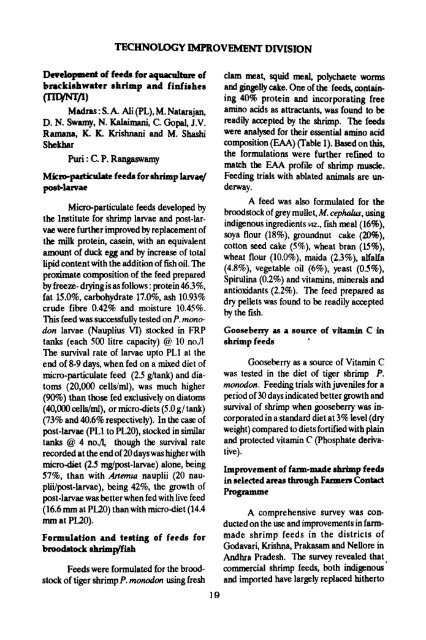annual report - Central Institute of Brackishwater Aquaculture
annual report - Central Institute of Brackishwater Aquaculture
annual report - Central Institute of Brackishwater Aquaculture
You also want an ePaper? Increase the reach of your titles
YUMPU automatically turns print PDFs into web optimized ePapers that Google loves.
TECHNOLOGY IMPROVEMENT DIVISION<br />
Developmmt <strong>of</strong> feeds for aq~ucdhm <strong>of</strong><br />
brackisbwater shrimp and finfishes<br />
m P )<br />
Madm : S. A. Ali (PL), M. Natarajan,<br />
D. N. Swamy, N. Kalaimani, C. Gopl, J.V.<br />
Ramana, K. K. Krishnani and M. Shashi<br />
SheLhar<br />
Puri : C. P. Rangawamy<br />
Mhputiculate feeds for shrimp larvae/<br />
post-1mae<br />
Micro-particulate feeds developed by<br />
the <strong>Institute</strong> for shrimp larvae and post-larvae<br />
were further improved by replacement <strong>of</strong><br />
the milk protein, casein, with an equivalent<br />
amount <strong>of</strong> duck egg and by increase <strong>of</strong> total<br />
Lipid content with the addition <strong>of</strong> fish oil. The<br />
proximate composition <strong>of</strong> the feed prepared<br />
by freeze- drying is as follows : protein 46.3%,<br />
fat 15.0%, carbohydrate 17.0%, ash 10.93%<br />
crude fibre 0.42% and moisture 10.45%.<br />
This feed was successfully tested onP. monodon<br />
larvae (Nauplius G) stocked in FRP<br />
tanks (each 500 litre capacity) 6) 10 no.11<br />
The survival rate <strong>of</strong> larvae upto PLl at the<br />
end <strong>of</strong> 8-9 days, when fed on a mixed diet <strong>of</strong><br />
micro-particulate feed (2.5 g/tank) and diatoms<br />
(20,003 cells/ml), was much higher<br />
(90%) than those fed exclusively on diatoms<br />
(40,000 crells/ml), or microdiets (5.0 gl tank)<br />
(73% and 40.6% respectively). In the case <strong>of</strong><br />
post-larvae (PLl to PL20), stocked in similar<br />
tanks @ 4 no.11, though the sumival rate<br />
recorded at the end <strong>of</strong> 20 dayswas higher with<br />
microdiet (2.5 mglpost-larvae) alone, being<br />
57%, than with Artemla nauplii (20 naupliilpost-larvae),<br />
being 42%, the growth <strong>of</strong><br />
post-larvae was better when fed with live feed<br />
clam meat, squid meal, polychaete worn<br />
and gingelly cake. One <strong>of</strong> the feeds, containing<br />
40% protein and incorporating free<br />
amino acids as attractants, was found to be<br />
readily accepted by the shrimp. The feeds<br />
were analysed for their essential amino acid<br />
composition (EAA) (Table 1). Bawd on this,<br />
the formulations were further refined to<br />
match the EAA pr<strong>of</strong>ile <strong>of</strong> shrimp muscle.<br />
Feeding trials with ablated animals are undelway.<br />
A feed was also formulated for the<br />
broodstock <strong>of</strong> grey mullet. M. cephalur, using<br />
indigenous ingredients vu., fish meal (16%).<br />
soya flour (18%), groundnut cake (a%),<br />
cotton seed cake (S%), wheat bran (IS%),<br />
wheat flour (10.0%), maida (2.3%), alfalfa<br />
(4.8%), vegetable oil (6%), yeast (O.S%),<br />
Spirulina (0.2%) and vitamins, minerals end<br />
antioxidants (2.2%). The feed prepared as<br />
dry pellets was found to be readily accepted<br />
by the fish.<br />
Goosebeny u, a source <strong>of</strong> vitamin C in<br />
shrimp feeda<br />
Gooseberry as a source <strong>of</strong> Vitamin C<br />
was tested in the diet <strong>of</strong> tiger shrimp P.<br />
monodon. Feeding trials with juveniles for a<br />
period <strong>of</strong> 30 days indicated better growth and<br />
survival <strong>of</strong> shrimp when gooseberry was incorporated<br />
in a standard diet at 3% level (dry<br />
weight) compared to diets fortified with plain<br />
and protected vitamin C (Phosphate derivative).<br />
Improvement <strong>of</strong> farm-made shrimp feeds<br />
in selected areas through Farmers Contact<br />
Prognmme<br />
(16.6 mm at PL20) than with minodiet (14.4 A comprehensive survey was conmm<br />
at PUO).<br />
ducted on the use and improvements in fam-<br />
~ ~ ~ md testhg ~ l<strong>of</strong> feeds d for i made ~ shrimp ~ feeds in the districts <strong>of</strong><br />
broodstock shrimP/fish<br />
Godavari, Krishna, Prakasam and Nellore in<br />
Andhra Pradesh. The survey revealed that.<br />
Feeds were formulated for the brood- commercial shrimp feeds, both indigenous<br />
stock <strong>of</strong> tiger shrimpP. monodm using fresh and imported have largely replaced hitherto

















